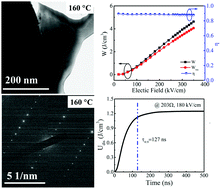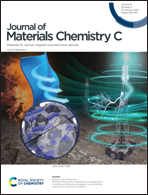Greatly enhanced discharge energy density and efficiency of novel relaxation ferroelectric BNT–BKT-based ceramics†
Abstract
The development of lead-free bulk ceramics with high recoverable energy density (Wrec) and high efficiency plays a major role in meeting the requirements for miniaturization and integration of advanced pulsed power capacitors. In this study, composition-dependent phase structures and ferroelectric properties of lead-free relaxor ferroelectric ceramics (1 − x)(0.84Bi0.5Na0.5TiO3–0.16K0.5Bi0.5TiO3)–x(Bi0.2Sr0.7TiO3) [(1 − x)(BNT–KBT)–xSBT, x = 0–0.45] are investigated. The introduction of SBT into the morphotropic phase boundary (MPB) BNT–BKT system constructs the relaxor ferroelectrics according to the order–disorder theory, leading to an improved energy storage performance. Results show that an ultrahigh recoverable energy density of 4.06 J cm−3 and a high energy-storage efficiency of 87.3% under an electric field of 350 kV cm−1 are achieved concomitantly, together with a superior high temperature stability (30–160 °C) and strong fatigue endurance (104 cycles). In particular, the corresponding ceramic exhibits an ultrafast discharge rate (τ0.9 = 127 ns) and a high level of discharge energy density (Udis = 1.29 J cm−3). Our study provides the groundwork for an effective way to design high-performance ceramics for application in next generation energy storage capacitors.

- This article is part of the themed collection: Journal of Materials Chemistry C Lunar New Year collection 2021


 Please wait while we load your content...
Please wait while we load your content...